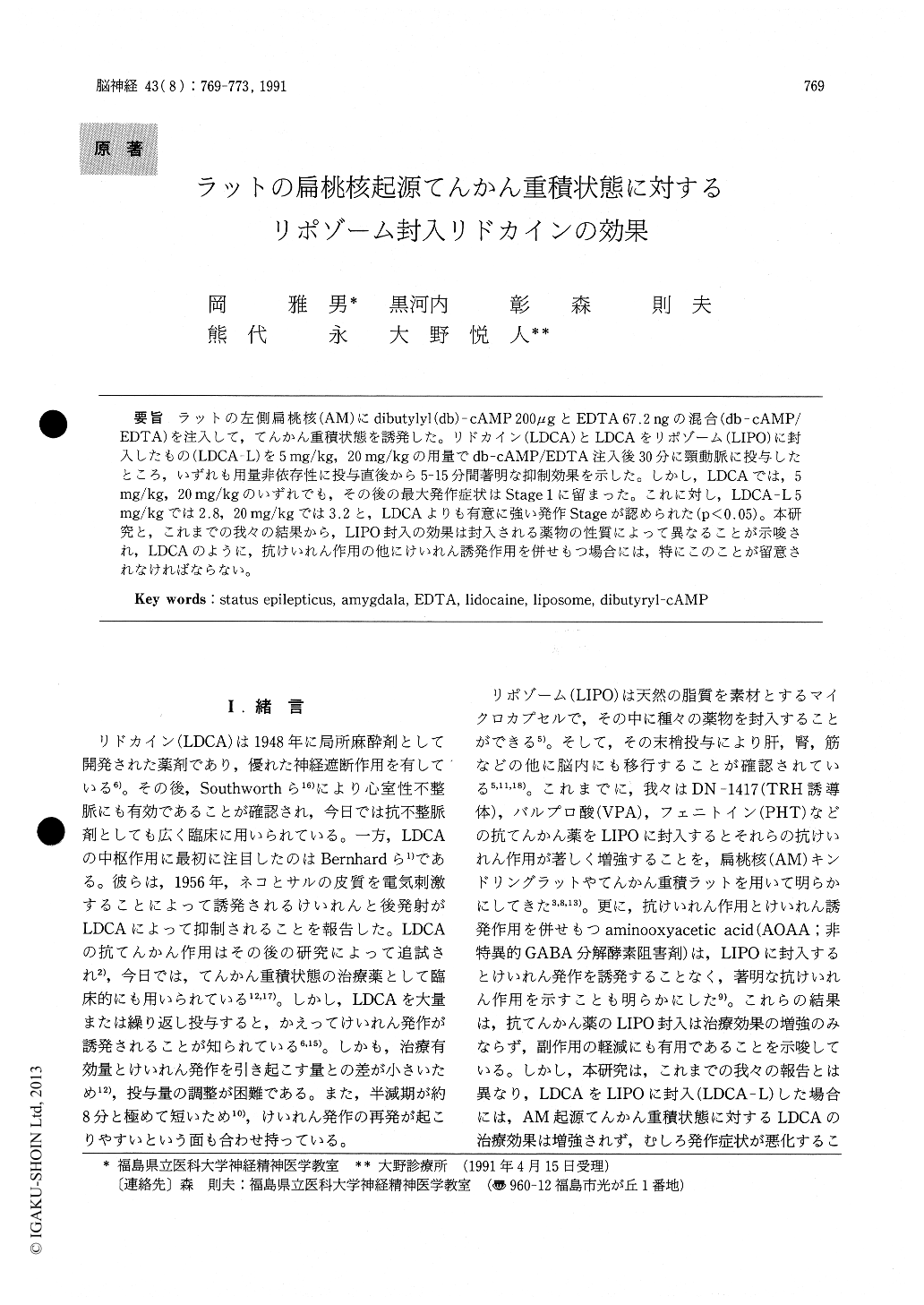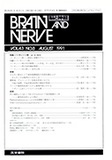Japanese
English
- 有料閲覧
- Abstract 文献概要
- 1ページ目 Look Inside
ラットの左側扁桃核(AM)にdibutylyl(db)-cAMP 200μgとEDTA 67.2ngの混合(db-cAMP/EDTA)を注入して,てんかん重積状態を誘発した。リドカイン(LDCA)とLDCAをリポゾーム(LIPO)に封入したもの(LDCA-L)を5mg/kg,20mg/kgの用量でdb-cAMP/EDTA注入後30分に頸動脈に投与したところ,いずれも用量非依存性に投与直後から5-15分間著明な抑制効果を示した。しかし,LDCAでは,5mg/kg,20mg/kgのいずれでも,その後の最大発作症状はStage 1に留まった。これに対し,LDCA-L5mg/kgでは2.8,20mg/kgでは3.2と,LDCAよりも有意に強い発作Stageが認められた(p<0.05)。本研究と,これまでの我々の結果から,LIPO封入の効果は封入される薬物の性質によって異なることが示唆され,LDCAのように,抗けいれん作用の他にけいれん誘発作用を併せもつ場合には,特にこのことが留意されなければならない。
Liposomes (LIPO), which are concentric lipid layers alternating with aqueous compartments, have been sug-gested as a potential carrier for various drugs. In the previous studies, we have demonstrated that anticonvul-sant drugs such as valproic acid, phenytoin, and DN-1417 (an analog of thyrotropin-releasing hormore) entrapped into LIPO exert more prominent therapeutic efficacy than parent drugs. In the present study, we examined the comparative effects of Lidocaine (LDCA)which acts as a proconvulsant as well as an anticonvul-sant, and LIPO-entrapped LDCA (LDCA-L) on limbic status epilepticus originating in the amygdala (AM) of rats.
LDCA (LDCA hydrochloride) was dissolved in dis-tilled water as a vehicle at a concentration of 2.5 mg/ ml or 10 mg/ml. LIPO and LDCA-L were prepared from L-α-phosphatidylcholine, cholesterol, and stear-ylamine. Status epilepticus was induced by intra-AM injection of combined dibutyryl (db)-cAMP-200 μg/ etylene diaminetetraacetic acid (EDTA)-67.2μg through the implanted cannula. The animals were divided into 4 groups which received vehicle (n=6), LIPO (n=5), LDCA (n=9), and LDCA-L (n=10). LDCA group was subdivided into 5 mg/kg (n=4) and 20 mg/kg (n=5) groups. LDCA-L group was treated with 5mg/kg (n=4) or 20mg/kg (n=6). All drugs were intravenouly given at a volume of 2ml/kg via teflon tube previously inserted into cervical vein 30 min after db-cAMP/EDTA injection.
Vehicle or LIPO alone did not alter the pattern of electroclinical ictal responses produced by intra-AM injection of db-cAMP/EDTA. The mean motor seizure stage was 3.7 in vehicle group and 3.4 in LIPO group.In contrast, both LDCA and LDCA-L markedly suppres-sed electroclinical ictal seizures immediately after the administrations lasting for 5-15 min. This acute and transient effect was non-dose-dependent, and there was no significant difference in this effect between LDCA and LDCA-L groups. In all the animals treated with 5mg/kg or 20 mg/kg of LDCA, motor seizure stage remained Stage 1. In LDCA-L group animals, however, the mean seizure stage was 2.8 with the 5 mg/kg dose and 3.2 with the 20 mg/kg dose. These values were not significantly different from that of vehicle or LIPO group, but markedly greater than that of LDCA-L group (p<0.05).
The present study indicates that LDCA entrapped into LIPO cannot exert increased therapeutic effect. Rather, LDCA-L exaggerated motor seizures. This result is in striking contrast to those of our previous studies, in which encapsulating of several anticonvulsants into LIPO showed more prominent effect than parent drugs. The reasons of the discrepancy between the present and previous studies are unknown, but at this point we are suggesting that effects of LIPO-entrapped anticonvul-sants drugs are influenced by nature of parent drugs.

Copyright © 1991, Igaku-Shoin Ltd. All rights reserved.


